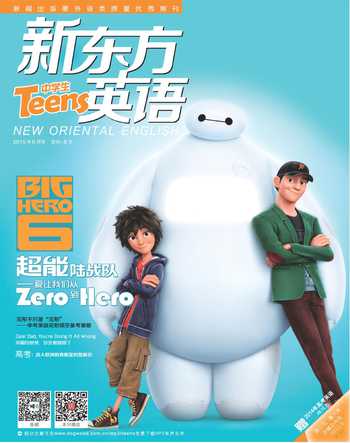Baymax Was Inspired by a Real Robot 你从哪里来,我的大白
2015-05-30朵朵
朵朵
看过《超能陆战队》的人,谁不想拥有一个又软又萌,既贴心又会照料人的大白呢?令人激动的是,也许在不久的将来,这个愿望就可以实现了!因为我们的大白并不是迪士尼的凭空想象,而是源于现实中的一项机器人研究。喜欢大白的亲们,还不快关注起来?
Big Hero 6 features Baymax—a lovable, soft, inflatable1) robot that looks like it came from Disney's fantasy machine more than anything in real life. The reality, however, is that it was inspired by hard-core2) robot research in a Pittsburgh lab.
In 2011, Carnegie Mellon University (CMU) scientist Siddharth Sanan, working with Mike Ornstein and Justin B. Moidel, under the guidance of Professor Christopher Atkeson, built a functioning, inflatable robot arm—a breakthrough in what is known as soft robotics. Soft robotics provide a number of real-world benefits, some of which are illustrated in Big Hero 6. In the movie, Baymax is a caregiver robot that attempts to take care of a boy, often by holding and picking him up. That human-robot interaction is not just movie fantasy—it's a very likely future here and around the world.
It's now widely believed that humans and robots will soon be working and living side-by-side in a variety of situations. In a sense, it's already happening. But today's robots are often purpose-built devices, specifically designed for one task and most of them are not built to come in contact with people. In fact, they're usually built to avoid human contact.
A few examples: iRobot's3) Roomba vacuum is flat and round so it can fit between chair legs and under furniture. It has sensors and bumpers4) to avoid obstacles and people. Industrial robots are usually built for manufacturing, and it would be catastrophic5) if they hit a co-worker. They usually work alongside other robots with little human interaction. Even the friendlier-looking Rethink Robotics6) Baxter, a manufacturing robot designed to be trained through human manipulation, is neither soft nor huggable.
Still, there is a real and growing need for robots that can touch and help people—and the solution to that is robots that look like Baymax.
According to the Population Reference Bureau, the human population is aging more rapidly than ever before. In 1950, there were 131 million people over 65. By 2010, there were 523 million over 65. In Japan, where the caregiver robot industry is flourishing7), around 25% of the population is over 65. An aging population will put increased pressure on caregiver services. Robots could fill the gap—but only if they can lift, hold, bathe and feed the elderly without harming them.
"For robots to be useful in performing assistive tasks, it is essential to control contact forces," Siddharth Sanan said in 2011. Sanan developed an inflatable robot arm then capable of bending at the elbow, opening and closing its puffy hand and even lifting objects, so long as they weighed no more than 1.1 lbs.
And that idea might have remained relatively obscure, had Big Hero 6 director Don Hall not made a visit to the lab in 2011. In an interview with Moviefone last summer, Hall explained how, on an early research trip for the movie, his team arrived at CMU's robot lab where they found Sanan and his inflatable robot arm. Hall said, "It was an inflatable vinyl8) arm and the practical application would be in the health care industry as a nurse or doctor's assistant. The minute he showed me that inflatable arm I knew we had our huggable robot."
One look at the CMU inflatable arm, and its influence on the vinyl Baymax is obvious. Like the fictional robot, it's all white, has visible stitching9) and is full of nothing but air. The CMU arm moves by courtesy of10) external actuators11) and pulleys12). Baymax moves in more mysterious ways.
"The one missing ingredient in [Baymax] is that you don't see how the system is actuated13)," Sanan said. "It just moves magically."
While Sanan has moved on from CMU—he's now at Harvard University's Wyss Institute—he is continuing his work in soft robotics. These days his focus is more on the wearable14) variety of robot skins. Think of wearable exoskeletons15), but potentially with soft, sensor-filled skin and inflatable muscles.
Carnegie Mellon's Professor Atkeson, who called Big Hero 6 "a tremendous win for soft robotics", has apparently also caught the Baymax bug16). Not only did his department partner with Disney for a Big Hero 6 costume contest, but he enthusiastically reported that CMU scientists are now working on building a real Baymax—if they can get the funding.
影片《超能陆战队》的主角大白是一位又软又萌的可充气式机器人,他看起来就像是来自迪士尼幻想世界的机器人,而非现实生活中的事物。但事实上,大白的设计灵感来源于匹兹堡一间实验室的核心机器人研究。
2011年,在克里斯托弗·阿特基森教授的指导下,卡耐基梅隆大学(CMU)的科学家西达尔特·萨南协同迈克·奥恩斯坦以及贾斯廷·B·莫伊德尔研制出一款运转良好的可充气机器臂——这成为现今为人所知的软机器人技术领域的一大突破。软机器人技术给现实世界带来许多便利,其中有些已在《超能陆战队》中得到展现。影片中,大白是一个护理机器人,努力照料着一个小男孩(译注:即主角小宏),常常会抱紧他或接住他。像这样的人机交互并不是仅存在于电影之中的虚幻情景,而是一种很有可能出现在这里以及世界各地的未来图景。
现在人们普遍认为,人类和机器人不久之后就会在各种各样的情境中并肩工作、共同生活。从某种意义上来说,这种情景已经出现了。不过,如今的机器人通常是针对某种特定目的而研制的设备,经过特别设计以完成某项任务,它们大多数都不是建造来与人接触的。事实上,制造它们时往往会着眼于避免与人类接触。
试举几例:iRobot公司的Roomba智能扫地吸尘机器人被设计成扁平的圆形,以便能在椅子腿之间和家具下面自如穿行。它自带传感器和缓冲器,从而能避开障碍物和人。工业机器人通常被用来进行加工制造,若与人类同事发生碰撞,将会带来灾难性的后果,因此,它们往往和其他机器人一起共事,几乎不会与人类产生互动。Rethink Robotics公司生产的Baxter看起来更为友好,是一款需要通过人类操控来进行训练的工业机器人,但即使这样,它也既不柔软,更不会令人想要拥抱。
然而对可触摸并可以帮助人类的机器人确实存在着需求,并且这种需求在与日俱增,而解决对策就是研制出像大白这样的机器人。
根据美国人口资料局的数据,目前世界人口老龄化的速度比以往任何时候都要快。1950年,全球65岁以上人口为1.31亿;到2010年,全球65岁以上人口已达到5.23亿。在护理机器人行业蓬勃发展的日本,65岁以上人口约占总人口的25%。人口老龄化将给护理行业带来不断增长的压力。机器人则可以弥补这方面的不足,但前提是它们可以在不对老人造成伤害的情况下将他们抱起、扶住,给他们洗澡、喂饭。
“为了使机器人可用于执行辅助性任务,我们十分有必要控制它们的接触力。”西达尔特·萨南于2011年如是说。萨南开发出了一款可充气式机器臂,它的肘部可弯曲,胖乎乎的手可以张开和握紧,甚至还能拎起重量不超过1.1磅的物体。
要不是《超能陆战队》的导演唐·霍尔在2011年拜访了那个实验室,护理机器人的理念可能还是会相对寂寂无闻。霍尔在去年夏天(译注:英文原文发表于2014年)接受Moviefone网站的采访时谈及,在为《超能陆战队》进行的早期探寻之旅中,他的团队来到了卡耐基梅隆大学的机器人实验室,在那里见到了萨南和他的可充气式机器臂。霍尔说:“那是一款可充气的聚乙烯基薄膜手臂,它的实际应用将会是在医护领域,充当护士或医生的助手。在他(编注:指萨南)向我展示那个机器臂的那一刻,我马上就意识到我们已经找到所需的可拥抱机器人了。”
只需看一眼卡耐基梅隆大学所研制的可充气机器臂,便会明白它对用聚乙烯基薄膜制成的大白的影响有多么明显。和电影中那个虚构的机器人一样,这一机器臂也是全白的,有着清晰可见的针脚,且充斥其内部的只有空气。该机器臂是通过外部传动装置和滑轮来驱动的,而大白则是以更为神秘的方式运行。
“[大白]身上没有体现的元素便是你看不出这个系统是如何驱动的,”萨南说,“它就是那么神奇地运行着。”
萨南现已离开卡耐基梅隆大学,去了哈佛大学维斯研究所,在那里继续进行着自己的软机器人研究。最近,他的研究重点更多地放在了机器人的各种可穿戴皮肤上。试想,机器人有着可穿戴的外骨骼,但同时又很可能拥有柔软且布满传感器的皮肤,以及可充气的肌肉,那该是怎样的情景。
卡耐基梅隆大学的阿特基森教授称《超能陆战队》是“软机器人领域的一项巨大胜利”,显然他也已经成了大白的粉丝。不仅他的研究室和迪士尼公司联合举办了《超能陆战队》主题的服饰比赛,他本人还满腔热情地表示卡耐基梅隆大学的科学家目前正在研制真正的大白——如果他们能够获得经费支持的话。
1. inflatable [?n?fle?t?bl] adj. 可充气的
2. hard-core: 中坚力量的;骨干的
3. iRobot: 美国一家机器人公司,成立于1990年,以其家用清洁机器人而著名。
4. bumper [?b?mp?(r)] n. 缓冲器;减震物
5. catastrophic [?k?t??str?f?k] adj. 灾祸性的;伤亡惨重的
6. Rethink Robotics: 美国一家新兴高科技公司,主要打造全新理念的工业机器人。
7. flourish [?fl?r??] vi. 繁荣;兴隆;茂盛
8. vinyl [?va?nl] n. 乙烯基;聚乙烯基薄膜
9. stitching [?st?t???] n. 缝线;针脚
10. by courtesy of: 由于……的作用
11. actuator [?kt?u?e?t?(r)] n. 传动装置
12. pulley [?p?li] n. 滑轮
13. actuate [??kt?ue?t] vt. 驱使;开动
14. wearable [?we?r?bl] adj. 可穿戴的
15. exoskeleton [?eks??skel?tn] n. 【动】外骨骼
16. catch the ... bug: 对……着迷
